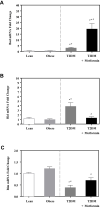Gene Expression Profiling of Apoptotic Proteins in Circulating Peripheral Blood Mononuclear Cells in Type II Diabetes Mellitus and Modulation by Metformin
- PMID: 33758522
- PMCID: PMC7979348
- DOI: 10.2147/DMSO.S300048
Gene Expression Profiling of Apoptotic Proteins in Circulating Peripheral Blood Mononuclear Cells in Type II Diabetes Mellitus and Modulation by Metformin
Abstract
Introduction: Insulin resistance in obesity and type 2 diabetes mellitus (T2DM) is associated with cardiovascular complications such as atherosclerosis. On the other hand, the reduction of apoptosis in macrophages has been linked with accelerated atherosclerosis. Apoptosis is controlled by a different family of proteins including Bcl-2 and caspases.
Methods: To examine apoptosis in insulin resistance, we assessed the mRNA expression by qRT-PCR of several Bcl-2 family members, as well as caspase-3, -7, -8, and -9 in peripheral blood mononuclear cells (PBMCs) isolated from lean, obese, diabetic, and diabetic on metformin individuals.
Results: PBMCs of diabetic individuals exhibited reduced expression of caspase-7 and increased expression of Bcl-10, Bad, Bax, Bid, and caspase-3. T2DM on metformin group had significantly higher Bad, Bax, and caspase-7 expression.
Discussion: The moderate up-regulation of pro-apoptotic Bcl-10, Bax, Bad, Bid, and the effector caspase-3 coupled with inhibition of caspase-7 in circulating PBMCs of T2DM could be the result of increased inflammation in T2DM. Metformin treatment significantly inhibited the expression of Bcl-10, Bid, and caspase-3 and upregulated Bad/Bax/caspase-7 pathway suggesting the activation of Bad/Bax/caspase-7 apoptotic pathway. Further studies are warranted to elicit the underlying apoptotic pathways of PBMCs in T2DM and following metformin treatment.
Keywords: BCl-10; BCl-2; PBMC; T2DM; apoptosis; caspase; peripheral blood mononuclear cells.
© 2021 Al Dubayee et al.
Conflict of interest statement
The authors report no conflicts of interest for this work and declare that the research was conducted in the absence of any commercial or financial relationships that could be constructed as a potential conflict of interest.
Figures






Similar articles
-
Regulation of the apoptosis/autophagy switch by propionic acid in ventromedial hypothalamus of rats with type 2 diabetes mellitus.Heliyon. 2022 Nov 14;8(11):e11529. doi: 10.1016/j.heliyon.2022.e11529. eCollection 2022 Nov. Heliyon. 2022. PMID: 36439719 Free PMC article.
-
Metformin alters peripheral blood mononuclear cells (PBMC) senescence biomarkers gene expression in type 2 diabetic patients.J Diabetes Complications. 2021 Jan;35(1):107758. doi: 10.1016/j.jdiacomp.2020.107758. Epub 2020 Oct 7. J Diabetes Complications. 2021. PMID: 33187870
-
Differential Expression of Human Peripheral Mononuclear Cells Phenotype Markers in Type 2 Diabetic Patients and Type 2 Diabetic Patients on Metformin.Front Endocrinol (Lausanne). 2018 Oct 9;9:537. doi: 10.3389/fendo.2018.00537. eCollection 2018. Front Endocrinol (Lausanne). 2018. PMID: 30356719 Free PMC article.
-
Apoptosis in pancreatic β-islet cells in Type 2 diabetes.Bosn J Basic Med Sci. 2016 Aug 2;16(3):162-79. doi: 10.17305/bjbms.2016.919. Epub 2016 May 22. Bosn J Basic Med Sci. 2016. PMID: 27209071 Free PMC article. Review.
-
Signaling of cell death and cell survival following focal cerebral ischemia: life and death struggle in the penumbra.J Neuropathol Exp Neurol. 2003 Apr;62(4):329-39. doi: 10.1093/jnen/62.4.329. J Neuropathol Exp Neurol. 2003. PMID: 12722825 Review.
Cited by
-
Graph Embedding Based Novel Gene Discovery Associated With Diabetes Mellitus.Front Genet. 2021 Nov 25;12:779186. doi: 10.3389/fgene.2021.779186. eCollection 2021. Front Genet. 2021. PMID: 34899863 Free PMC article.
-
Dysregulation of Gene Expression of Key Signaling Mediators in PBMCs from People with Type 2 Diabetes Mellitus.Int J Mol Sci. 2023 Feb 1;24(3):2732. doi: 10.3390/ijms24032732. Int J Mol Sci. 2023. PMID: 36769056 Free PMC article.
References
LinkOut - more resources
Full Text Sources
Other Literature Sources
Research Materials

